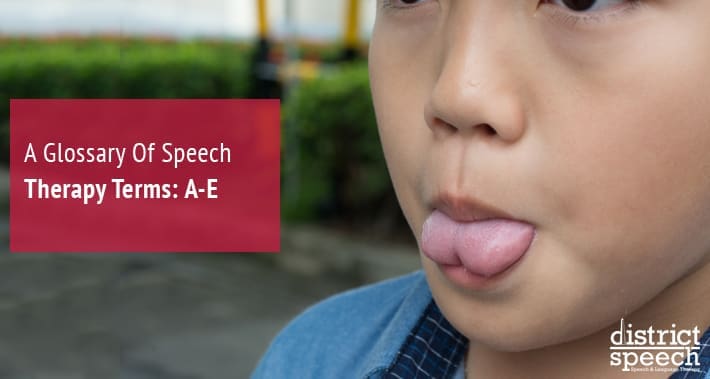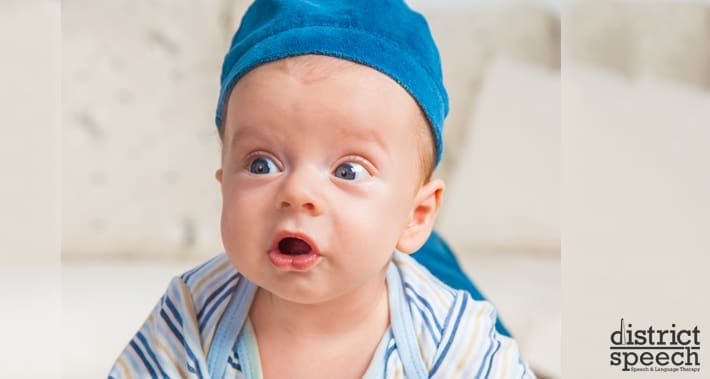
Understanding the terminology of your healthcare is one of the most important factors in any type of therapy.
After all, it’s hard to follow your speech therapist’s instructions if you haven’t a clue what they’re talking about.
We’re District Speech, a Washington DC speech therapist who knows how important client education is.
Our professional staff are dedicated to making sure you understand exactly what will happen during therapy.
Let’s take a look at some of the most commonly used speech therapy terms that you might hear your therapist using.
RELATED: Speech Therapy Terms: F-M, Speech Therapy Terms: N-O, Speech Therapy Terms: P-R, and Speech Therapy Terms: S-Z.
Ankyloglossia
More commonly known as “tongue tie”, ankyloglossia is a birth defect that limits tongue movement.
Typically, the tongue stays attached to the floor of your mouth with the help of a small web of tissue called the lingual frenulum.
In people with ankyloglossia, the lingual frenulum is shortened or thickened and may cause significant speech difficulties.
Apraxia Of Speech
Apraxia of speech is an articulation disorder that causes difficulty forming the facial positioning and muscular movement required for speech.
For instance, if you’ve been diagnosed with apraxia of speech, you might struggle to pronounce vowel sounds, such as “o”.
In mild cases, apraxia of speech is sometimes referred to as dyspraxia.
Articulation
Articulation refers to the formation of speech sounds.
Proper articulation for most speech sounds requires coordination between your lips, tongue, teeth, mouth, and respiratory system.
Any disorder or defect surrounding these body parts can lead to articulation difficulties.
Articulators
As the name implies, your articulators help with proper articulation.
Your articulators are the organs that help produce meaningful sound.
Some of your articulators include your lips, lower jaw, velum, tongue, and pharynx.
Augmentative And Alternative Communication (AAC)
Augmentative and alternative communication, or AAC for short, refers to a group of therapeutic techniques used by speech therapists.
AAC techniques help to support and enhance communication in people who struggle with verbal communication.
Examples of AAC techniques include sign language, facial expressions, and body movements.
Babbling
Babbling is a form of communication for young infants who haven’t yet learned how to form coherent words.
It’s very common for babies to begin babbling during the second half of their first year of life.
If your baby is beginning to babble, you can be sure that they’ll begin talking full sentences in no time.
Bilabial
Bilabial refers to making speech sounds and articulations that require movement of both of your lips.
Therefore, bilabial words are words that require precise movement from both of your lips to properly articulate, such as the “p” and “m” sounds.
Examples of bilabial words include “purse”, “mouse”, and “black”.
Bilingual
Being bilingual means knowing how to fluently speak two languages.
Bilingualism is common amongst children of first generation immigrant parents.
Raising your child in a bilingual household can provide them with a variety of benefits, including enhanced problem solving skills, creativity, and flexible thinking.
Bolus
A bolus is a term used to describe the ball of saliva and food that forms in your mouth right before you swallow.
This process of chewing is important for proper digestion.
Some neurological disorders, such as cerebral palsy or Parkinson’s disease, can interfere with the way your bolus forms and subsequently cause feeding and swallowing difficulties.
Carryover
During speech therapy, your speech therapist will remind you to practice your newly learned speech and language techniques in your everyday life, outside of therapy.
At some point, you will begin to use these techniques naturally without the need for reminders.
This process is referred to as carryover.
Cueing
Cueing is a therapeutic technique used in speech therapy to encourage a desired response.
For instance, your speech therapist might instruct you to read from a sheet of paper while pointing towards the paper in question.
By cueing, your speech therapist is further clarifying the instructions that they’re giving to you for better comprehension.

Deglutition
Deglutition refers to the act of swallowing food or saliva.
Certain swallowing disorders, such as dysphagia, can interfere with your deglutition.
Dental Arch
Your dental arch refers to curved structure that holds your teeth.
It consists of your gums and your alveolar bone.
Your dental arch helps to ensure a proper bite, with your upper teeth laying slightly in front of your lower ones when biting.
Deviation
Deviations refer differences from what is typically expected in any given situation.
For instance, most people are born with a lingual frenulum that allows for easy tongue movements.
However, some people are born with tongue tie and struggle to move their tongues.
Therefore, babies born with tongue tie are considered deviations from typically developed infants.
Diadochokinesis
In speech, diadochokinetic refers to the ability to make rapid, repetitive movements while talking.
People with this ability can move their articulators, such as their lips and tongues, freely and repetitively.
If you’re capable of rapidly pronouncing tongue twisters with ease, you have high diadochokinetic skills.
Dysarthria
Dysarthria is a term used to reference a group of motor speech disorders caused by an impairment in the central or peripheral nervous systems.
Dysarthria disorders may interfere with a wide range of speech and language skills, such as respiration, articulation, phonation, resonation, and prosody.
Dysfluency
Dysfluency refers to any type of speech characterized by speech flow interruptions.
More commonly known as stuttering, dysfluency is characterized by repetitions, prolongations, and hesitations in speech.
Echolalia
Echolalia is a skill most babies learn during infancy.
This skill involves the ability to repeat words and simple sentences that’re being spoken.
Echolalia repetitions can happen either immediately following hearing a word or phrase or delayed.
Epenthesis
Epenthesis refers to the tendency to add unnecessarily phoneme, or sounds, in a word or group of word.
For example, someone with epenthesis might pronounce “taree” instead of “tree”.
Book Your Appointment With District Speech Today
As you can see, there’s a lot of terminology associated with speech therapy.
This list has hardly even touched the surface!
At District Speech, our staff are happy to answer any of your questions or go into further detail about the terminology discussed here.
Book your appointment with District Speech today to get answers to all your questions and to learn more about our services.
1300 I St NW, #400E,
Washington, DC 20005
- https://g.page/districtspeech
District Speech and Language Therapy specializes in speech therapy, physical therapy, and occupational therapy solutions, for both children and adults, in the Washington D.C and the Arlington Virginia areas.